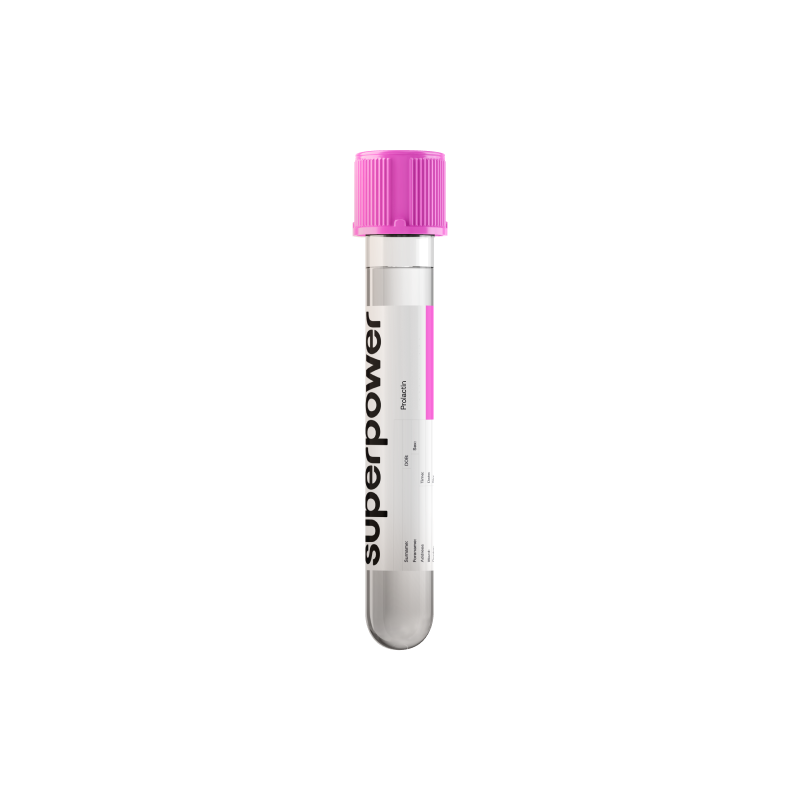Prolactin is a pituitary hormone that shapes reproductive, lactation, and thyroid balance. It affects cycles, fertility, sexual wellness, mood, and bone health by modulating estrogen and testosterone through pituitary–gonadal signaling.
Prolactin levels rise naturally with pregnancy, breastfeeding, stress, and sleep, and can shift with medications or thyroid changes.
Testing helps reveal whether prolactin is contributing to symptoms such as irregular periods, infertility, low libido, erectile issues, or nipple discharge, and provides a clear baseline to track over time.
Key Benefits
- Find prolactin imbalance that can disrupt periods, fertility, libido, and lactation.
- Explain nipple discharge, missed periods, low libido, or erectile issues with objective levels.
- Flag pituitary causes when levels are very high, guiding imaging and specialist care.
- Guide treatment for pituitary tumors or medication-induced elevations using repeat testing.
- Protect fertility by restoring ovulation or testosterone when prolactin is normalized.
- Support pregnancy and postpartum care by distinguishing normal from concerning prolactin changes.
- Track response to prolactin-lowering medication and monitor tumor control over time.
- Best interpreted with TSH, pregnancy test, medication review, and morning repeat if borderline.
What is Prolactin?
Prolactin is a protein hormone (peptide) that circulates in the bloodstream. It is produced mainly by specialized cells called lactotrophs in the front lobe of the pituitary gland beneath the brain (anterior pituitary/adenohypophysis). Smaller amounts can be made in other tissues such as the uterus and immune cells. Its release is held back by the brain’s dopamine signal (hypothalamic dopaminergic inhibition) and can be prompted by estrogen and thyrotropin‑releasing hormone (TRH), as well as by the nipple‑to‑brain reflex during nursing.
Prolactin’s central job is to start and sustain milk production in the breast after pregnancy (lactation), and to help the mammary gland mature before birth. It also links energy balance and reproduction by slowing the brain’s reproductive pulse generator (GnRH), which naturally reduces ovulation during breastfeeding. Beyond lactation, prolactin has broader “growth factor–like” actions on immune cells and metabolism (via the prolactin receptor/PRLR and JAK‑STAT signaling). As a biomarker, it reflects pituitary lactotroph activity and the balance of brain signals that promote or restrain it in states like pregnancy, sleep, stress, and nursing.
Why is Prolactin important?
Prolactin is a pituitary hormone best known for enabling milk production, but it also signals how the brain–pituitary–gonadal axis is running. Because prolactin is held in check by dopamine, it reflects the balance between stress responses, thyroid input, and reproductive hormones. When it’s off, fertility, sexual function, bone strength, and mood can be affected.
In nonpregnant adults, typical values are about 3–15 in men and 5–25 in women, with pregnancy and breastfeeding driving much higher levels as a normal adaptation. For most nonpregnant people, feeling well aligns with the low-to-mid part of the reference range.
When prolactin runs unusually low, it often points to reduced pituitary signaling or excess dopamine effect. Physically, most people feel fine, but after childbirth it can cause poor or absent milk production. Because low prolactin may accompany other pituitary hormone deficits, there can be broader effects such as fatigue or low libido if multiple axes are involved.
When prolactin is elevated, it dampens hypothalamic GnRH, lowering LH and FSH. In women this can bring irregular or absent periods, infertility, vaginal dryness, and sometimes nipple discharge; in men it can cause low testosterone, decreased libido, erectile dysfunction, and reduced sperm production. Teens may see delayed or stalled puberty. Longstanding elevation raises risk for bone loss via hypogonadism. Pregnancy and breastfeeding are physiologic causes of high values; hypothyroidism, certain medicines, and pituitary adenomas are common nonphysiologic causes.
Big picture: prolactin links the dopaminergic, thyroid, and reproductive systems. Sustained imbalance chiefly impacts fertility and bone health, with ripple effects on energy and sexual well-being, making it a valuable window into pituitary and whole‑body physiology.
What Insights Will I Get?
Prolactin is a pituitary hormone best known for initiating and sustaining milk production, but it also modulates the reproductive axis, stress responses, immune activity, and metabolism. It is under constant brake by brain dopamine. When prolactin rises, it suppresses GnRH, which lowers LH/FSH and sex steroids; this links prolactin to energy, bone health, fertility, mood, and cognition.
Low values usually reflect strong dopamine inhibition (often medication-related) or reduced pituitary reserve. In nonpregnant adults this is often asymptomatic. In postpartum women it can present as poor milk production. When low prolactin accompanies other low pituitary hormones, it flags hypopituitarism, with system-level effects such as fatigue, low blood pressure, reduced stress tolerance, and infertility from low gonadotropins.
Being in range suggests intact hypothalamic–pituitary regulation with stable feedback to the reproductive system. In nonpregnant adults, values commonly sit in the low-to-mid portion of the reference interval, consistent with regular menstrual cycling or normal testosterone physiology, steady bone turnover, and balanced metabolic signaling.
High values usually reflect pregnancy or lactation, sleep and acute stress, medications that block dopamine, too little thyroid hormone, kidney disease, or a prolactin-secreting pituitary tumor. System effects arise from suppressed gonadotropins: irregular or absent menses, infertility, low libido or erectile dysfunction, galactorrhea, decreased bone density, and low energy or cognitive fog; headaches or vision changes suggest mass effect.
Notes: Prolactin varies with time of day, stress, exercise, and nipple/chest wall stimulation; mid-morning, resting samples are more comparable. Assays can be confounded by macroprolactin (high lab value with few symptoms) or rarely the hook effect at very high levels. Interpretation differs in pregnancy and early postpartum.



.svg)



.png)
.png)
.png)
.png)








